[ad_1]
Everyone can see that AMD Ryzen 5000 CPUs are enjoying a dynastic run of greatness. In our review of desktop Ryzen 5000 chips, they obliterated Intel’s desktop Core CPUs turning them overnight into good value chips. The same could be said of AMD’s Ryzen 5000 H-class chips in larger gaming laptops, which also outclassed the equivalent Intel CPUs.
The last win AMD is trying to notch won’t be so easy. Unlike Intel-based desktops and larger gaming laptops, which are powered by older and slower 14nm chips, the thin-and-light category of sub-three-pound laptops actually feature Intel’s most advanced CPUs: Its 11th-gen Tiger Lake. Built on its 10nm FinFET process using its newest cores and its best integrated graphics, Intel’s Tiger Lake CPUs won’t be the pushovers its 14nm siblings are. But when you’re on a roll like Ryzen 5000, it’s hard to see AMD coming up short. So sit back to see if Ryzen can make it three in a row.
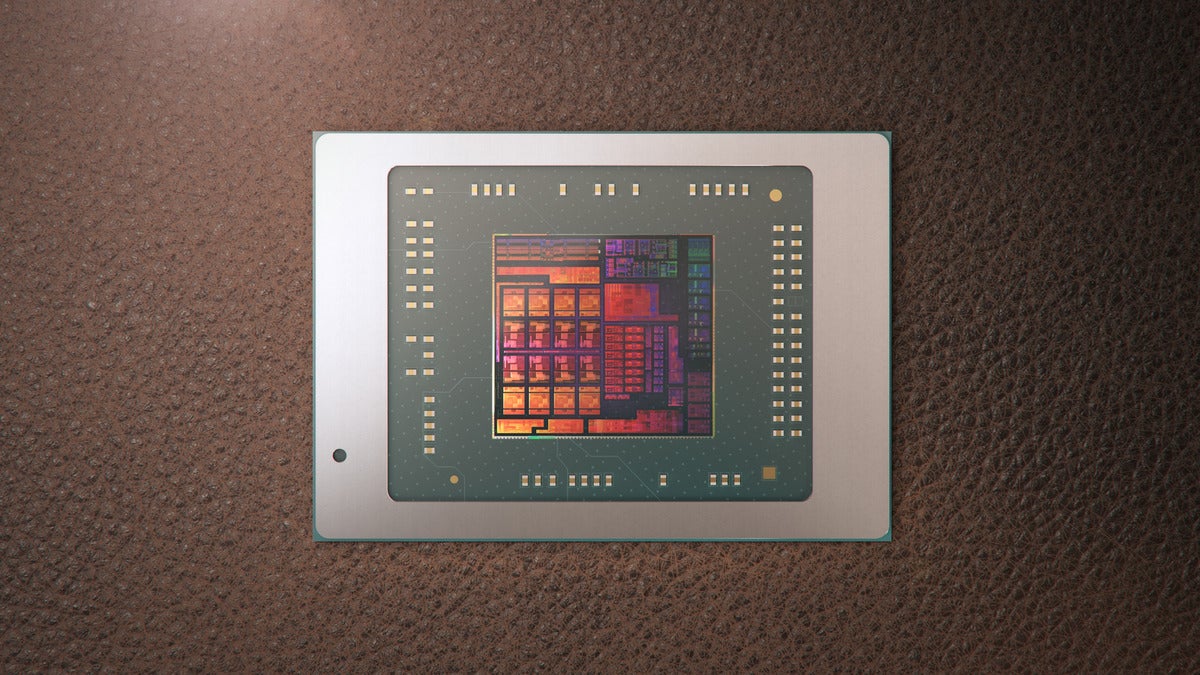 AMD
AMDAMD’s last stop to claim complete performance dominance over consumer PCs is to beat Intel’s 11th gen Tiger Lake.
What is Ryzen 7 5800U?
Our review of the Ryzen 9 5980HS CPU. goes into detail about the Ryzen 5000 family. They are, for the most part, the same CPUs in core count and microarchitecture design. What sets the Ryzen 7 5800U apart from a Ryzen 9 5980HS, -H or -HX chip is simply how hot it’s allowed to run. While an H-class CPU might run at 45 watts and higher, most U-class chips have to fit into a 15-watt envelope.
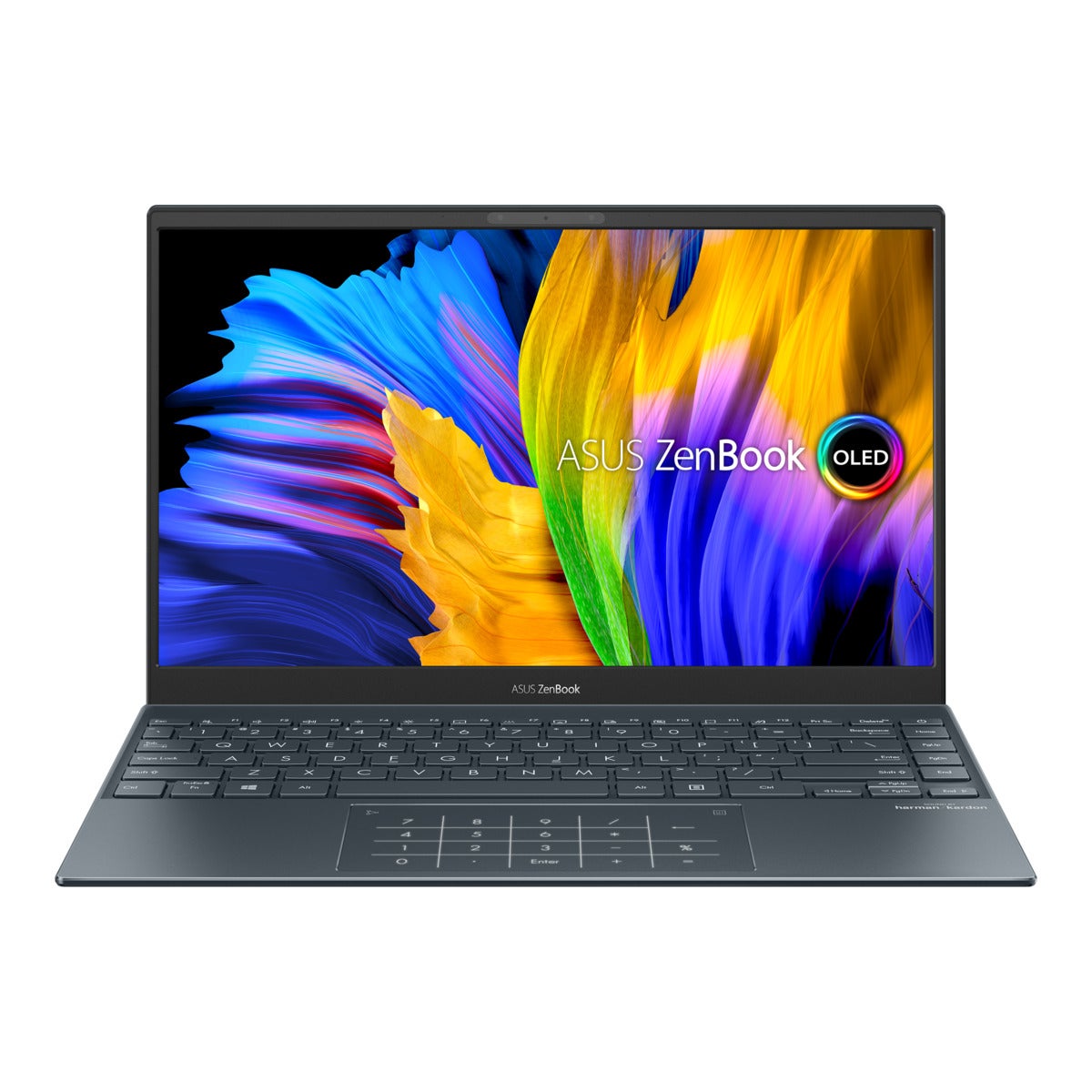 Asus
AsusThe Asus ZenBook UM325 features a beautiful OLED screen and Ryzen 7 5800U CPU.
How we tested
Our test laptop is the Asus ZenBook UM325. It features an eight-core Ryzen 7 5800U, Radeon graphics, 16GB of LPDDR4X/4267, a 1TB PCIe 3.0 SSD, and a 13.3-inch FHD OLED screen. It weighs 2.6 pounds.
For our PC comparisons, we decided to pick laptops that are similar in size and weight:
- MSI’s Prestige 14 Evo is equipped with a four-core, 11th-gen Core i7-1185G7 with Iris Xe graphics, 16GB of LPDDR4X/4267 memory, a 512GB PCIe Gen 4 SSD, and a 14-inch FHD screen. It weighs 2.7 pounds.
- Lenovo’s Yoga Slim 7 has an eight-core Ryzen 4800U with Radeon graphics, 16GB of LPDDR4X/4267 memory, a 512GB PCIe 3.0 SSD, a 14-inch FHD, and lap weight of 3.1 pounds.
- Dell XPS 13 7390 has a six-core 10th-gen Core i7-10710U, UHD Graphics, 16GB LPDDR3/2667, a 512GB PCIe 3.0 SSD, 13.3-inch 4K screen, and lap weight of 2.8 pounds.
- Dell XPS 13 2-in-1 7390 has a four-core 10th-gen Core i7-1065G7, Iris Plus 940 graphics, 16GB of LPDDR3/3777, 512GB PCIe 3.0 SSD, 13.4-inch FHD+ screen, and lap weight of 2.9 pounds.
Limitations of laptop testing
When you look at the performance charts below, remember that laptops aren’t as apples-to-apples comparable as desktops. While we believe the laptops here yield generally representative performance for each CPU, you cannot separate the CPU from the motherboard and cooling system attached to it, nor the individual PC maker’s recipe for how to run that chip. That basically means you’ll get some laptops with the same CPU that might be slightly faster, or slightly slower.
3D Rendering Performance
We’ll kick off our performance testing with Maxon’s popular Cinebench R20. Based on the engine from its commercial Cinema4D, it’s a quick and easy way to gauge performance of a CPU using all of its cores and threads while rendering a 3D scene.
Intel is no fan of Cinebench, arguing that it’s of little value to look at 3D performance when so few people would do that on a sub-three-pound laptop. It’s a fair point, but we find it valuable to gauge multi-core performance. We’d also argue that newer CPUs may finally make such tasks feasible on smaller laptops.
It’s also obvious who’s in front here: The 8-core Ryzen 7 5800U chalks up a hefty 58-percent advantage over the 4-core Core i7-1185G7. The Ryzen 7 5800U also shows a decent, if not knock-your-socks-off, 12.6-percent improvement compared to the Ryzen 7 4800U in the Lenovo Slim 7.
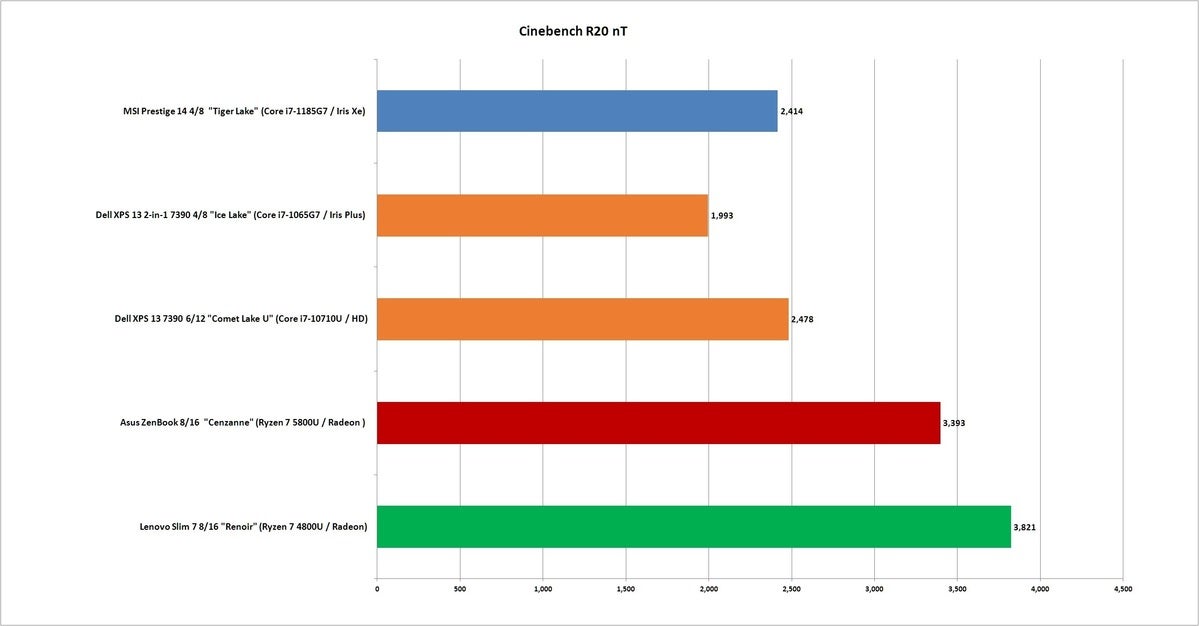 IDG
IDGLonger bars indicate better performance.
As we noted before, very few users actually run multi-threaded applications, where an 8-core chip pays its biggest dividends. Most tasks and applications on the PC are still single-threaded, so we also run Cinebench R20 in that mode to gauge how the CPUs perform under a heavy, but single-threaded load.
The overall winner here is Intel’s Core i7-1185G7, which edges out the new Ryzen 7 5800U by about five percent. Both are clearly head and shoulders above their predecessors, so if you want the snappiest lightly threaded response, either Ryzen 5000 CPU or Intel 11th-gen will do.
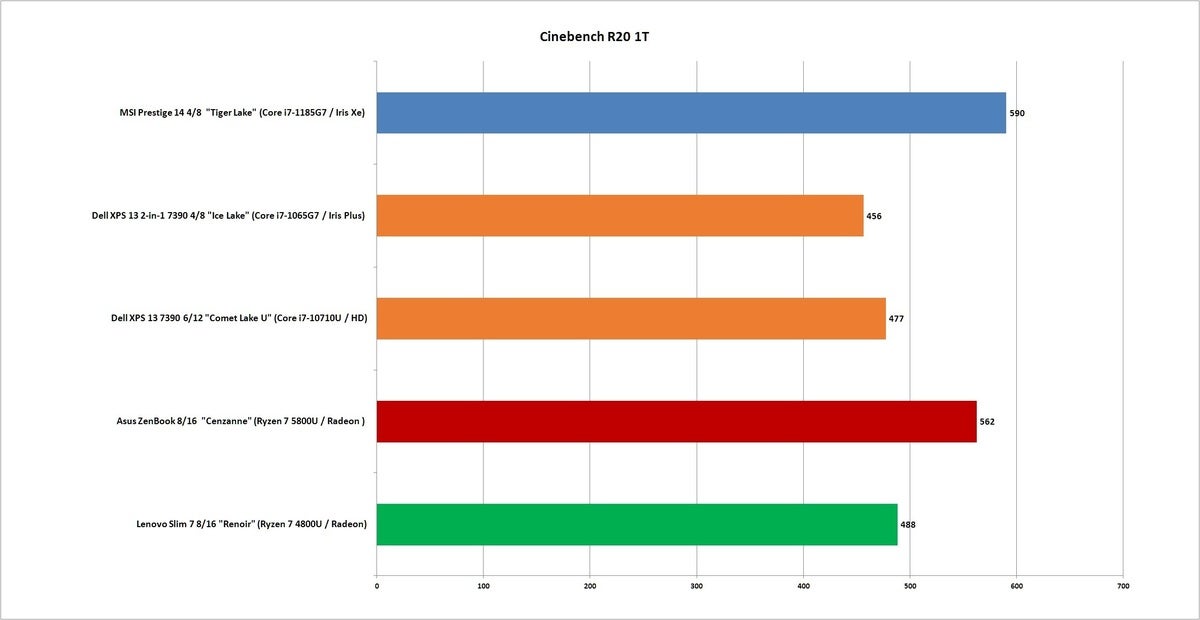 IDG
IDGLonger bars indicate better performance.
We could run another five 3D modelling applications, but we don’t need to do that to tell us that if you need a laptop to give you more more multi-core performance, you simply want one with more cores in it. You can see that clearly in the last 3D modelling result we show you: V-Ray Next 4.10 which puts the Ryzen 7 5800U 48 percent ahead of the Core i7-11857. Put a fork in it, because it’s done in this department.
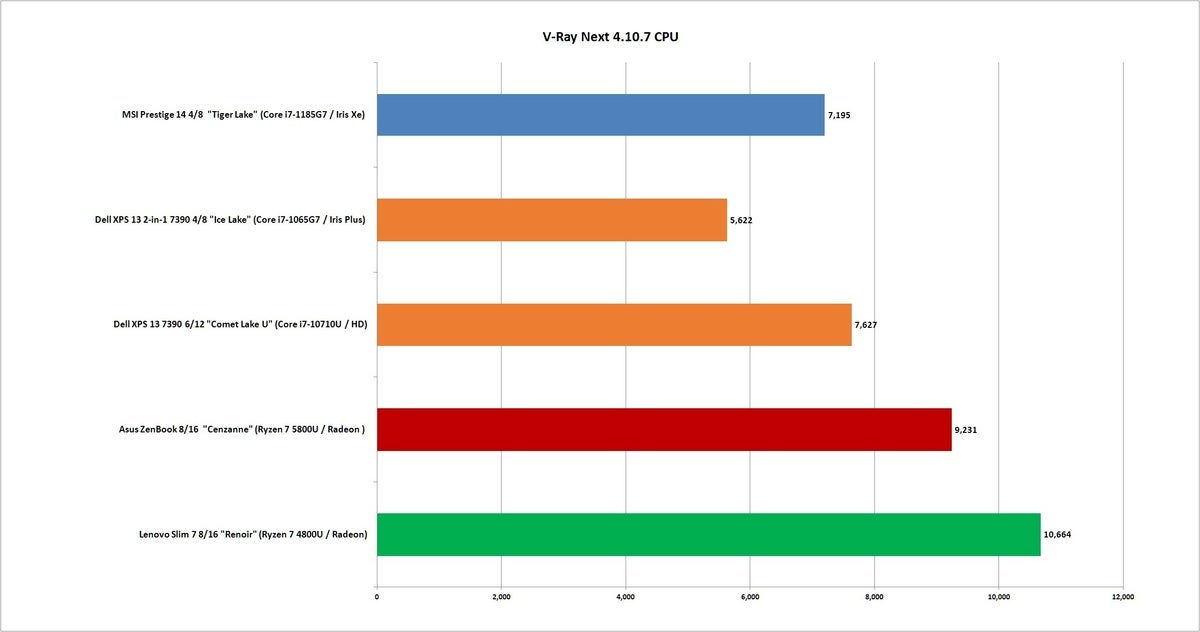 IDG
IDGLonger bars indicate better performance.
Video Encoding Performance
Moving onto a more common multi-core task, namely a video transcode, we use an older version of the free HandBrake utility to convert a 30GB 1080p video file for Android tablet use. This task favors more cores, and because it takes so long to complete, laptops with better cooling tend to do better as well.
The winner here is actually the Lenovo Slim 7 and its 7-core Ryzen 7 4800U, but we can call its 5.7-percent edge a virtual tie. Why didn’t the newer Ryzen 7 5800U prevail? We suspect what we’re seeing here is a result of the cooling subsystem of both Ryzen laptops at play. The ZenBook just doesn’t get that loud, which tells us Asus may not crank the fans as hard as the Lenovo Slim 7 does.
What’s more important for AMD, though, is it continues to rule tasks that want more cores. The 8-core Ryzen 7 5800U finishes the encode 32 percent faster than the Core i7-1185G7.
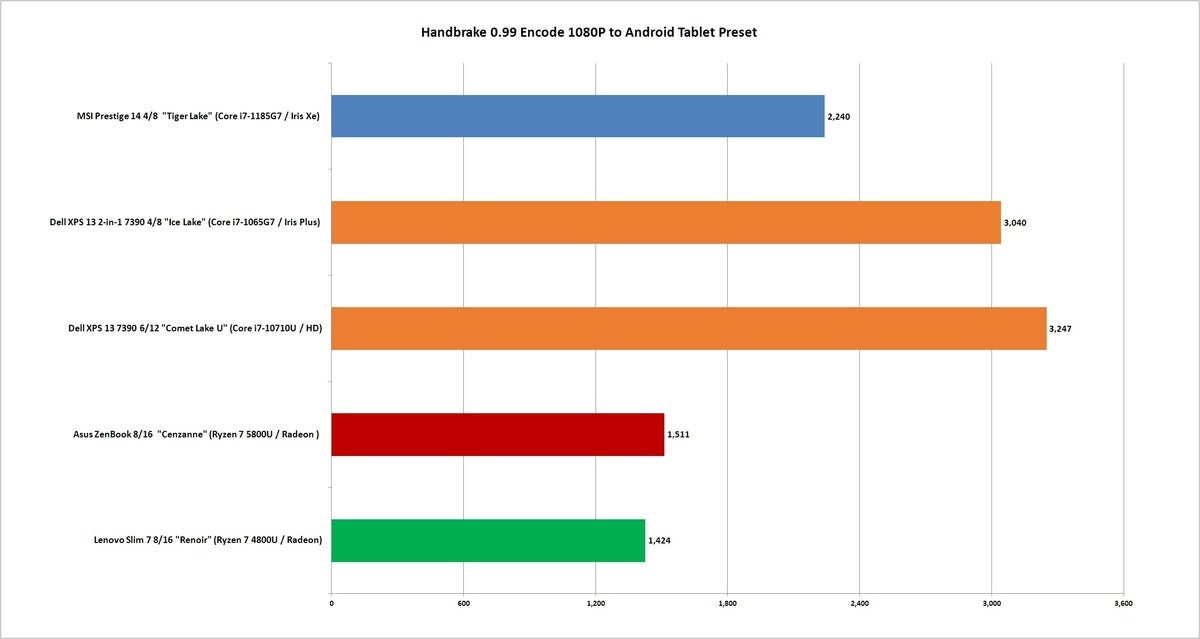 IDG
IDGShorter bars indicate better performance.
There’s an argument that CPU-encodes always yield the best output, but for most people, using the chip’s integrated hardware media encoders in the GPU is the way to go. To measure both laptops, we installed the latest final public version 1.3.3 of HandBrake, and then had both encode the open-source 4K Tears of Steel video using the HEVC codec to 1080p resolution at 60 fps. For the Intel CPU, we used QuickSync, and for the AMD CPU we use VCE.
Both make quick work of the task, but the winner is the Ryzen 7 5800U, which crosses the finish line 15 percent sooner than the Core i7-1185G7. The one variable we don’t consider here is the output quality between them, but that’s for another story.
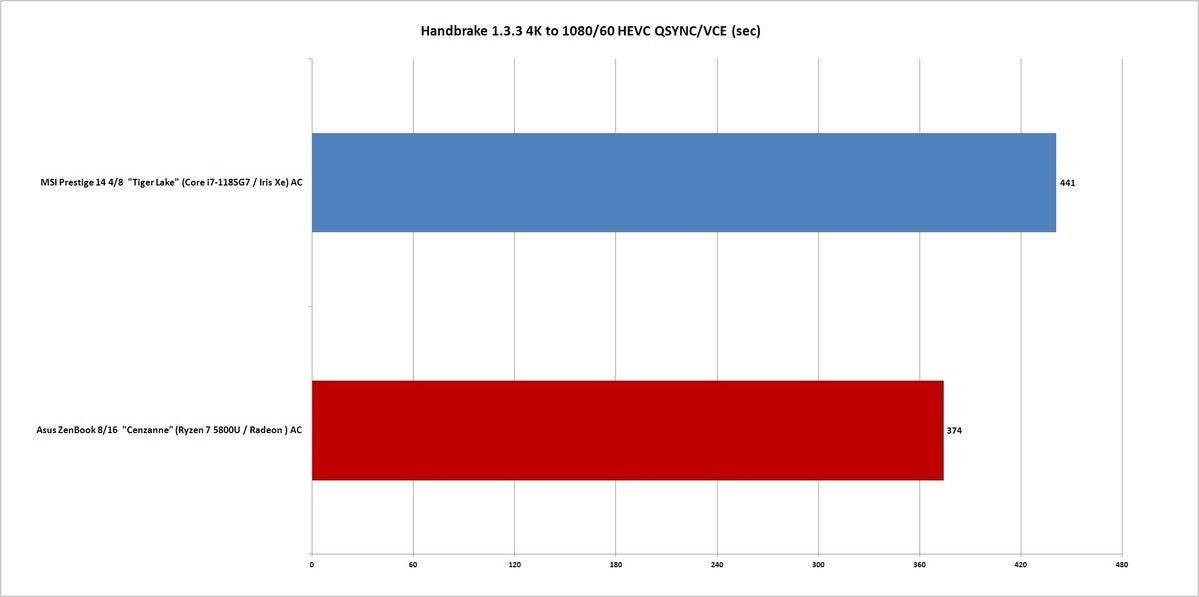 IDG
IDGShorter bars indicate better performance.
Office and Adobe Application Performance
One argument that Intel has made (and we largely agree with) is most people use very light laptops for doing very mundane things—not running 3D modelling or encoding hours and hours of video.
Nothing says ‘mundane’ like the Microsoft Office chores that fill the day for many office drones. For that task, we used PCMark 10 Applications, which runs Microsoft Word, Excel, PowerPoint, and Edge through scripted tasks.
This is a test where the 11th-gen Intel CPU outshines AMD’s previous Ryzen 7 4800U by a compelling 18 percent. With the improved IPC efficiency of the Ryzen 7 5800U we now find AMD slightly ahead—about 6 percent faster than the 11th gen Core i7-1185G7 chip. It’s pretty much up a toss-up, but when you consider past performance, this is a big win for AMD.
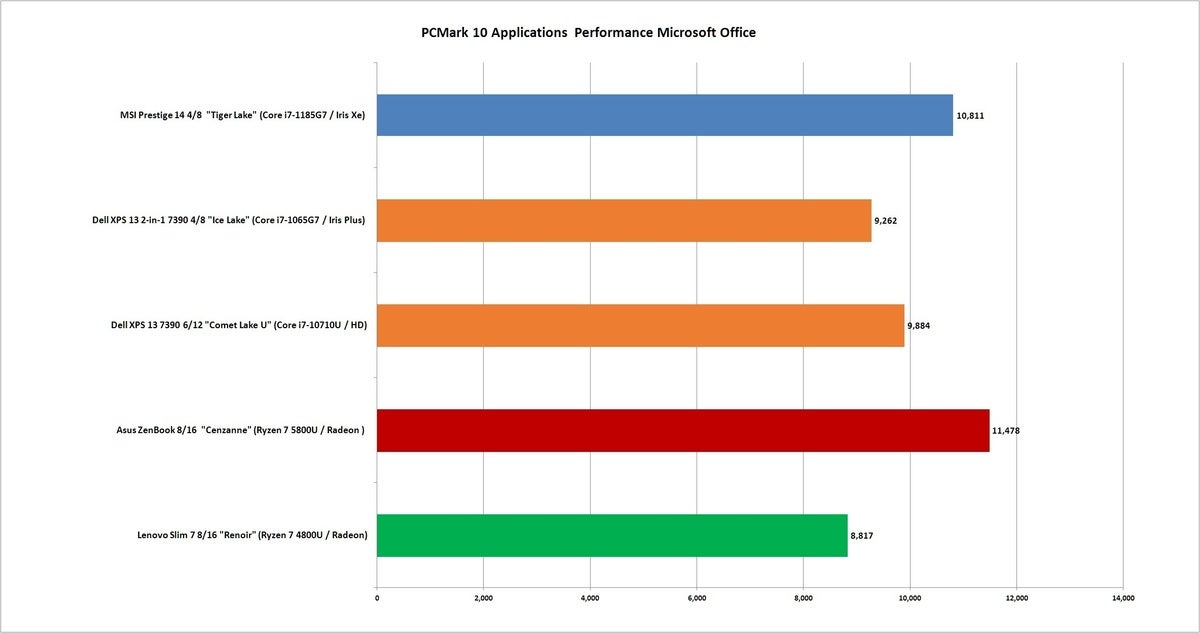 IDG
IDGLonger bars indicate better performance.
Before we move on from boring old Office, we do want to touch on a problem Intel has taken pains to cite: Ryzen performance drops off the cliff when the laptop’s on battery. To test that claim, we re-ran PCMark 10 Applications with the two newest laptops plugged in, and then on battery with the Windows 10 power performance slider set to “better battery.” The darker colors in the chart indicate the AC performance, while the brighter, lighter colors indicating DC performance.
You can see the Core i7-1185G7, takes about a 30-percent haircut on battery, while the Ryzen 7 5800U takes a 48-percent hit. There’s more to be said on this topic later on, but it’s worth noting how the battery life of this Ryzen laptop suffers. So maybe Intel has a point here.
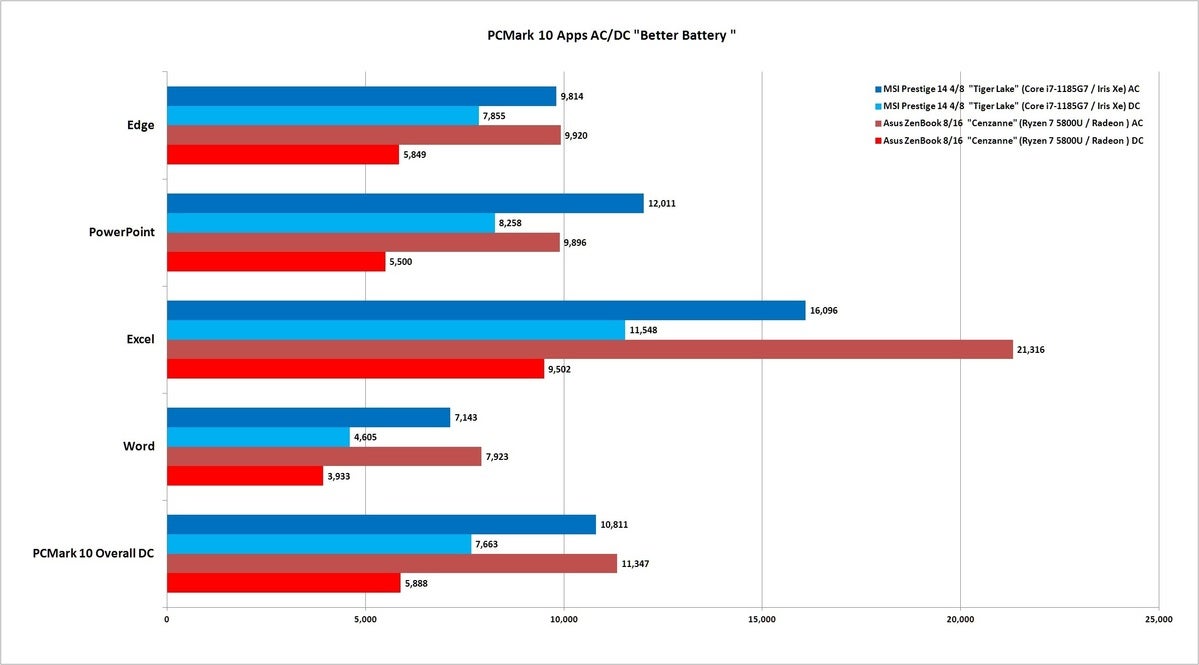 IDG
IDGLonger bars indicate better performance.
Moving on to the other popular suite of applications you actually enjoy using, we use UL Procyon to measure performance of the Ryzen 7 5800U and Core i7-1185G7 in Adobe Photoshop 22.3, and Lightroom Classic 10.2. We only have results for the top two laptops here because we wanted to use the latest versions of Photoshop and Lightroom Classic available to us. We feel that’s important, because processor and compiler optimizations matter.
You should know both applications are intense, but they don’t always use all of the CPU cores. The GPU, as well as the ability to maintain high clocks, and vendor optimizations matter.
Although that red AMD bar is longer, we’re looking at mostly a tie here, with the overall score differing by only 2 percent.
If you were an Intel fan, you’d say despite the eight cores in that Ryzen, the four-core Core i7 does just as well in this popular and strenuous task. If you were an AMD fan, you’d say that despite the very high clock speeds of the Core i7 and optimization that tend to favor Intel, it’s basically a tie. And you still get those extra cores.
If you have no skin in the game: You should basically know both are very good chips to have for Photoshop and Lightroom.
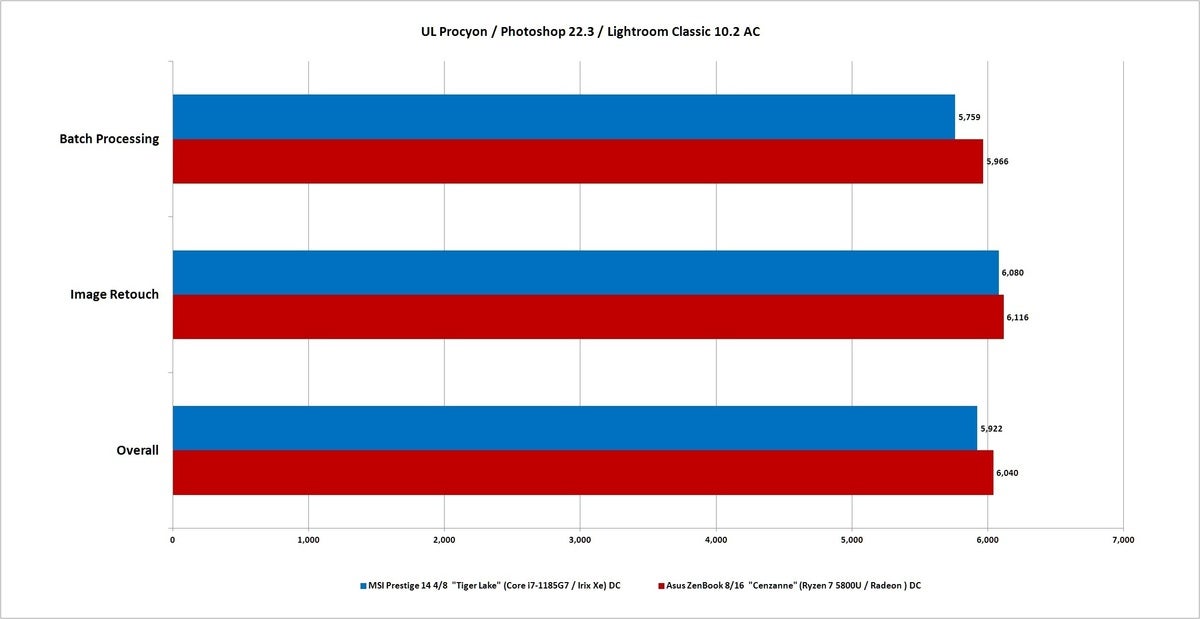 IDG
IDGLonger bars indicate better performance.
One issue with a sprawling suite such as Adobe Creative Cloud is that different tasks may favor one chip, while another may favor the other. To get a second opinion on Photoshop performance, we also run PugetBench 0.93, a test made by workstation maker Puget Systems to help advise its customers on what hardware to.
PugetBench also agrees . We see about a 2 percent separation between both chips. Basically, you can’t lose with either again.
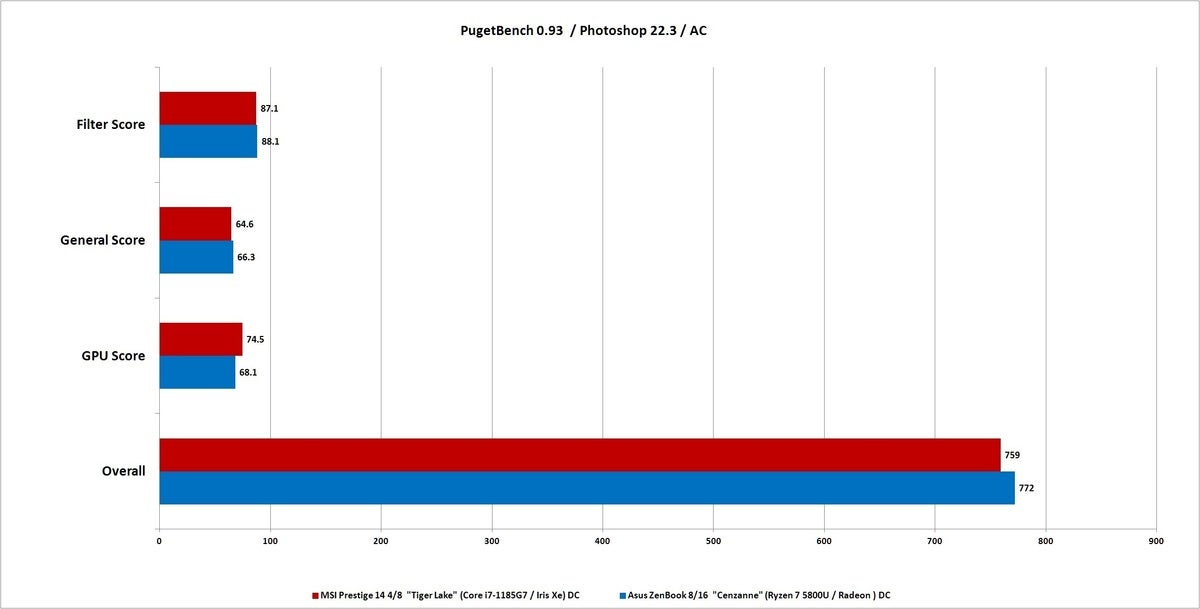 IDG
IDGLonger bars indicate better performance.
We’ll close off our Adobe testing with UL Procyon Video test which measures a computer’s performance using Adobe Premiere to add several effects to a video while exporting it several different ways.
The winner? Intel’s Core i7-1185G7 by a decent 16.5 percent.. As we said above, these sprawling suites perform differently based on what you actually do, and optimizations for Intel CPUs do indeed yield real benefits which you’re seeing here. So win, at least, in Procyon Video, goes to Tiger Lake. We do know certain tasks in Premiere can push it back to AMD but this one goes to Intel.
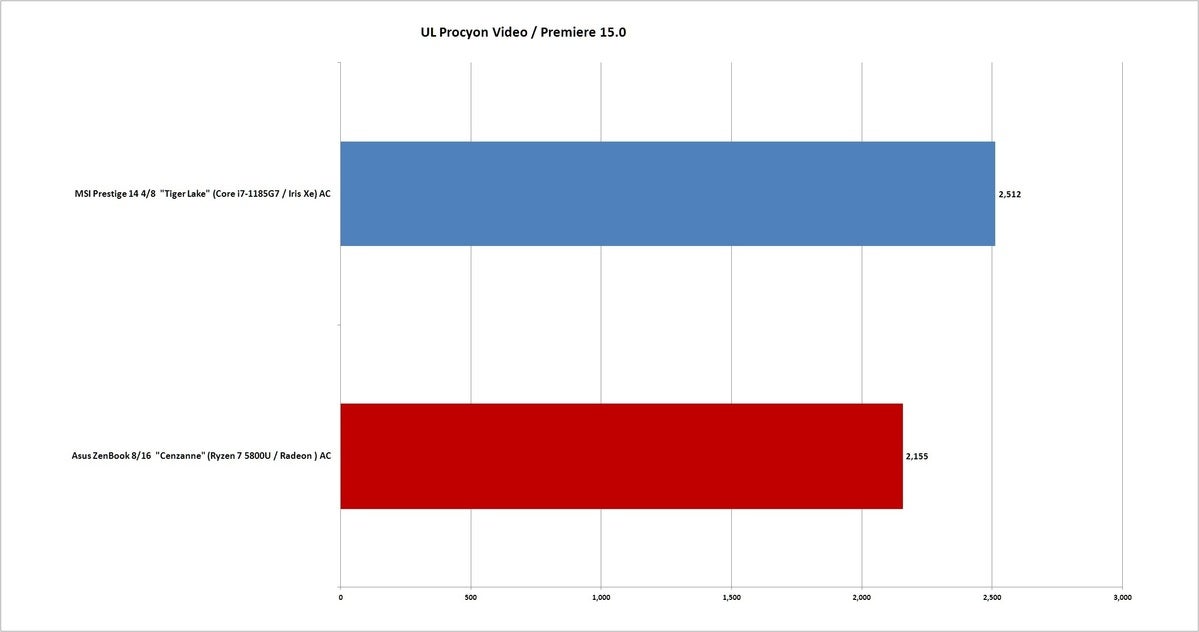 IDG
IDGLonger bars indicate better performance.
We know you’re here for gaming performance, so keep reading to see all the charts.
[ad_2]
Source link